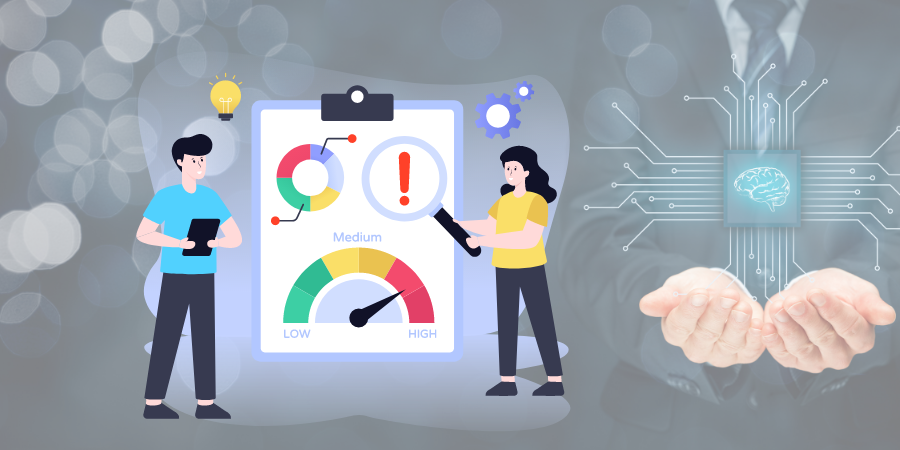
Over the decades, AI has swiftly entered into the typical business ecosystem, transforming its reputation across several industries. A fast-paced paradigm switch towards the digitalization of many sectors has advanced human expertise.
Adopting rapid digitalization, companies are producing unprecedented amounts of data exponentially, and AI can operate and analyze such data and information more effectively and accurately.
At the same time, digitalization expands enormously, and new technological innovations emerge each year. The risk associated with personal and commercial data is rising as well. This is the picture where AI has been established as a game-changer.
AI-enabled technologies are aimed to detect and alleviate risk in such data-intensive eco-space. AI-powered technologies serve as an unrivaled tool for detecting and mitigating risks in today’s data-intensive environment.
This article will look at how AI-powered tools and solutions can assist in risk assessment. Let’s first discuss what risk assessment is.
Understanding Risk Assessment
The process of recognizing and analyzing potential risks to select appropriate safety measurements is known as risk assessment. These safety arrangements can be implemented across a variety of conditions, for example, the building of a product, comprehensive data analysis, workplace organization, and management.
The risk evaluation method comes while enterprises need to make decisions for the issues without transparent, explicit regulatory and compliance management.
Risk assessment is crucial to make effective decisions when businesses face situations of uncertainty. Specific to domains, business environments, strategies, and relevant factors, a business can have various types of risks despite common goals. Leveraging analytical measures, the method predicts possible damages generated from entrepreneurial risks.
How AI Benefits in Risk Assessment
Risk assessment facilitates work efficiency, diminishes losses, and maximizes revenue. Businesses can manage to head risks more effectively with relevant innovations, let’s say with Artificial Intelligence.
Data Classification
Depending on the priorly defined data patterns and categories, AI tools can analyze and categories available data and information. By monitoring data access, AI can take more preventative risks measurements.
Threat Analysis and Management
AI algorithms have the capabilities to scrutinize the massive amount of data extracted from multiple resources to detect liability, prospect, or uncertainty. These models can generate real-time predictions assisting risk managers and security experts in dealing with risks swiftly.
AI models are designed to make an early warning signal to ensure that any interrupted operation inside organizations and protect its stakeholders from any sort of misconduct.
Reduction in Risks
AI also can evaluate unstructured data about risky behaviors or activities in the organization’s operations. AI algorithms can identify patterns of behavior related to past incidents and transpose them as risk predictors.
AI solutions can investigate unstructured data- the data that tells risky practices or behaviors about operations of the organizations.
In a practical approach, AI models identify odd data patterns or unusual behavior from previous incidents, learn from them and expose possible risk predictors.
Fraud Detection
Traditionally, fraud detection demands an intense analysis process for financial bodies and insurers. AI-enabled systems reduce the processes’ workload and thereby cut down fraud threats.
Alongside credit card transactions, banks serve as a rich data source to process and educate unsupervised learning algorithms. For example, banks have been using ML techniques for analyzing credit card portfolios for years. These algorithms can accurately anticipate credit card counterfeit as ML models have the strength to build, train and authorize massive data.
The transactions made by credit card payment systems are connected with workflow systems monitoring those transactions to access possible frauds. Such transactional data show credit card portfolios and allow banks to distinguish amidst particular features associated with fraudulent and non-fraudulent transactions.
Trade Practices and Behavior
AI-based technologies such as NLP and text mining are hugely employed for governing trading activities, for example- rouge trading, trading manipulation, etc. By examining trade data- email traffic, calendar data, check-in/check-out data, call timing alongside trading portfolio data, etc., the systems can anticipate the possible faults, such as misconduct of trading, liquidity risks, adverse effects of price of assets, low-market prices, and many more. This practice saves millions, market risks, and reputational risks of financial institutions.
Conclusion
AI has become a reliable assistant for enterprises. Evidence shows a breathable digital revolution not only makes people’s lives easier but also holds challenges and new opportunities.
So far, we have seen how AI can combat risk assessment. There are a variety of fields where AI-powered solutions can be implemented for risk evaluation and prevention. However, attention should be paid to avoiding undesirable consequences of AI to manage severe risks without errors.



























 Batoi Corporate Office
Batoi Corporate Office